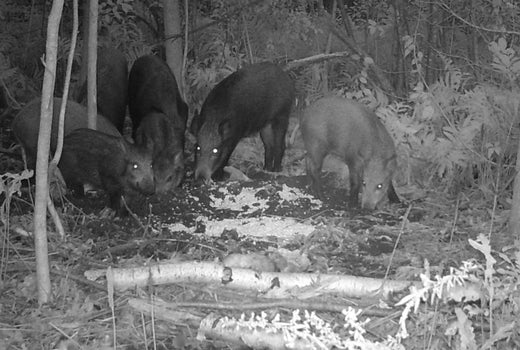Wild boars are highly intelligent and alert animals. Even when installing an electric fence as a countermeasure against crop damage, it is necessary to devise an installation method to increase the effect.
In this article, we will explain the mechanism of the electric fence for wild boars and the effective installation method from 7 points. Let's check the proper installation method so that the effect of defense can be increased as much as possible.
How to use an electric fence as a countermeasure against wild boars?
When an electric fence is used as a countermeasure against wild boars, electricity is applied to the protective fence surrounding the crops, and an electric shock is given to the wild boars that try to enter. The aim is to make the wild boar avoid fences by learning fear rather than physically damaging them with electric shocks.
Wild boars are highly cautious and have the habit of carefully observing the area in which they live. At that time, it tries to obtain various information mainly using its nose, but when the wire of the electric fence touches the nose part, an electric shock will occur.
The purpose of this electric shock is to make the boars "pain" and "fear" so that they learn that "this place is dangerous, so let's stay away" and keep them away from crops to prevent damage.
How an electric fence works
When nothing touches the wire, the current (+) output from the main body of the electric fence flows through the wire. In addition, the ground (-) is taken from the main body to the ground.
*The current does not flow all the time, but is an intermittent pulse current with an energization time of 0.01 seconds or less per second, so it is not capable of killing animals. Even if a human accidentally touches it, a serious accident can be avoided.
In this state, when an object that conducts electricity easily, such as the tip of the boar's nose, touches the wire, an electric path is created in the order of the wire, the body of the boar, the ground, and the body of the boar. As a result, the wild boar receives an electric shock, but the degree of pain is similar to a strong static electricity "bachi". When receiving an electric shock, the boar will startle and run away.
As an image, it is a mechanism like a miniature light bulb that is often seen in science experiments. The electric fence body is a dry battery, the electric wire is a conductor, and the boar is a switch. When the boar's nose is touched and a switch is turned on, electricity is applied and the miniature light bulb glows (an electric shock occurs).
Therefore, it is very important to devise the installation location and method so that electricity can flow properly.
7 points on how to install an effective electric fence
It is important to firmly hold down the points of installation in order to increase the effectiveness of wild boar countermeasures using electric fences. Here are seven points on how to install.1. Ensure proper energization
When installing an electric fence, it is important to ensure proper electrical conditions. It is necessary to check that there is no short circuit in the electric wire part and that there is no problem with the conductivity of the ground.
Make sure there is no leakage
A common pattern is that the wire is in contact with a conductive object such as a guardrail or galvanized iron, causing an electric leak. In addition, electric wires may touch grass, trees, or stones without realizing it, causing short circuits. If there is a short circuit, the voltage of the entire electric fence will drop, so it will not be possible to give a sufficient electric shock to the boar.
Also, avoid wrapping the wires directly around the posts without using insulators. Even if the fence is made of a non-conductive material, electric fences are high voltage and will leak. Even if you use insulators, the wires may not be installed properly and touch the metal part, so check carefully during installation.
Pay attention to the conductivity of the ground
I touched on the mechanism of the electric fence earlier, but the electric fence works like a miniature light bulb, and when a wild boar touches it, a circuit is created between it and the ground (earth), and electricity flows.
However, if the ground where the fence is installed is in a state where it is difficult to conduct electricity, sufficient effects cannot be obtained. Specifically, avoid places such as concrete, asphalt, and cobblestones.
In addition, depending on the geology and soil conditions, such as dry soil, it may be difficult to ground due to poor electrical conduction. If the place where you want to install the fence is close to concrete or asphalt, you can either adjust the installation location so that the fence is as far away from the concrete as possible, or you can lay down a galvanized plate with good conductivity so that it functions as a ground. .
Also, when using a grounding rod to ground between the ground and the main unit, check whether the grounding rod is properly buried in the ground at the installation location and whether it is disconnected.
It is important not only to check the proper energized state at the time of installation, but also to check periodically after installation.
2. away from slopes
If you install an electric fence, keep it away from slopes. If you set up a fence right next to a slope, the wild boar will use the height of the slope to jump over the fence. *It is said that wild boars can jump more than 1m without running up. Place it on flat ground at a distance of 2m from slopes.
Also, if there are dents in the ground under your fence or power lines, it's a good idea to level the ground first, as wild boars may crawl under your electric fence. If you can't make it flat, try adding wires to the dented part so that there are no gaps.
3. cut weeds
If there are weeds near the electric fence, cut them beforehand. As mentioned above, if there are weeds, etc. in contact with the electric wire, it will cause a short circuit and make it difficult for electricity to flow.
In addition to weeds, touching fallen trees, dead branches, puddles, etc. will also reduce the effect. It is important to perform regular inspections and maintenance both during installation and after installation.
Four. Eliminate hiding places for wild boars
Wild boars are very cautious and will try to observe them carefully when an electric fence is installed. At that time, if bushes and weeds that can hide wild boars are growing near the fence, it will not only affect the electric current status of the fence, but also become a route for wild boars to easily enter the vicinity of the electric fence. It's going to be.
If wild boars often use these routes, they may lower their psychological alertness and become accustomed to electric fences. Be sure to remove bushes and weeds in the vicinity of the electric fence where wild boars can hide in advance.
Five. Eliminate gaps in electric fences
Install an electric fence around the area you want to protect. If there is a weak spot, the boar will find it and try to enter. When other wild boars saw it, they began to imitate it, and the electric fence that was put up with much effort sometimes stopped functioning as a protective fence.
Especially when installing over a wide area, it is easy to have weak spots, so make sure that the area to be protected is properly surrounded by electric wires.
6. Place it at the height of the boar's nose
When installing an electric fence, set the wires at the height of the boar's nose as a guide. A wild boar's body is densely covered with hair, and electric current does not pass through the fence if it touches the body. It is strong and has high physical ability, so it may knock down fences and invade.
The part to aim for is the tip of the boar's snout, which is sensitive. Assuming the height of a wild boar's snout, install the electric wire at a height of about 40 cm from the ground. At the same time, electric wires will be installed at a position of about 20 cm from the ground to prevent wild boars from crawling under the fence.
If you install it in a low position, it will be effective as it will also be a countermeasure against small uribou. 『2. If there is a dent in the ground as introduced in "Keep it away from the slope", install another electric wire so as not to create a gap.
7. Supply electricity for 24 hours
After installing the electric fence, please turn on the electricity for 24 hours.
Wild boars will perceive the electric fence as "just a string" if you use it so that it does not conduct electricity during the bright hours of the day and allows it to pass only at night. This does not instill a sense of fear, and it will enter the fence even when the current is flowing.
Let's run the power supply 24 hours a day so that the wild boar always recognizes that it is dangerous and should not be approached. Also, when installing an electric fence, please put it into operation as soon as possible after installation so that there is no time without electricity.
If the boar breaks through the fence while it is not in operation, it will perceive the fence as not scary and stop being afraid of it. If this happens, even if you start energizing later, the effect will be weak.
Installation takes time, especially when installing over a wide area, but make a plan in advance so that wild boars do not come close to the fence when the power is off.

 箱罠
箱罠
 くくり罠
くくり罠
 パーツ類
パーツ類
 電気柵
電気柵
 自作キット
自作キット
 防獣グッズ
防獣グッズ
 監視カメラ
監視カメラ










 box trap
box trap
 tying trap
tying trap
 enclosure trap
enclosure trap
 Prevention and avoidance goods
Prevention and avoidance goods
 electric fence
electric fence
 trap surveillance camera
trap surveillance camera
 transportation goods
transportation goods
 Trap detection sensor
Trap detection sensor
 hunting supplies
hunting supplies
 hunting books
hunting books
 Anti-bird goods
Anti-bird goods
 Agricultural materials/machinery
Agricultural materials/machinery
 boar
boar
 deer
deer
 Kyon
Kyon
 monkey
monkey
 raccoon
raccoon
 Badger
Badger
 palm civet
palm civet
 raccoon dog
raccoon dog
 nutria
nutria
 mouse or rat
mouse or rat
 Mole
Mole
 bear
bear
 pigeon
pigeon
 Crow
Crow







